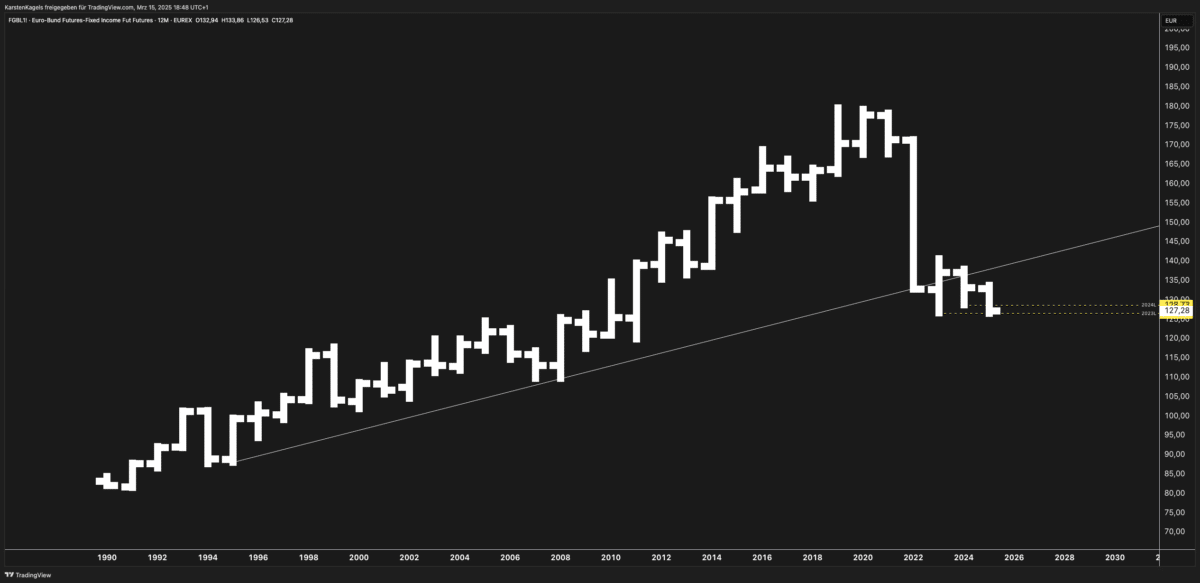Introduction: What is the Bund Future?
The Bund Future (FGBL) is one of the most traded fixed-income derivatives in Europe. It represents a 10-year German government bond and is primarily used by institutional investors, hedge funds, and retail traders to hedge interest rate risk or speculate on bond price movements. Given its importance in the European financial landscape, an accurate Bund Future price forecast is critical for traders and investors alike.

Historical Trends & Technical Analysis
Long-Term Performance
Analyzing the long-term price chart, the Bund Future experienced a multi-decade uptrend, driven by declining interest rates and global quantitative easing. However, a significant breakdown occurred in recent years, leading to a strong bearish move.
Key Technical Indicators
- Trendline Analysis – The previous long-term uptrend has been breached, confirming a structural shift in the market.
- Fibonacci Retracement – The price has retraced to a key Fibonacci support level near 127.00, which could act as a potential base.
- Moving Averages – The 200-month moving average was broken decisively, indicating a strong bearish momentum.
- Support & Resistance Levels – Critical support near 125.00, resistance near 135.00 – 140.00.
Macroeconomic Factors Impacting Bund Future Prices
1. ECB Monetary Policy & Interest Rates
The European Central Bank (ECB) plays a crucial role in the Bund Future’s trajectory. If inflation remains stubbornly high, the ECB may continue its restrictive stance, keeping bond prices under pressure.
2. Inflation Outlook
High inflation has historically led to rising yields, which inversely affect bond prices. The Bund Future’s decline aligns with Europe’s inflationary challenges.
3. Economic Growth in the Eurozone
A slowing European economy could lead to a return of bond buying as investors seek safety, potentially supporting Bund Futures.
4. Global Bond Market Correlations
The Bund Future often moves in sync with US Treasury yields and other major bond markets. A rise in US yields could weigh further on the FGBL price.
Comparative Analysis: Bund Future vs. Other Assets
1. Bund Future vs. German DAX
Historically, bond prices and stock indices have had an inverse relationship. When Bund Futures decline, equities tend to rise due to risk-on sentiment.
2. Bund Future vs. US Treasury Bonds
The 10-year US Treasury yield heavily influences Bund Futures. Any divergence between US and German yields can create arbitrage opportunities for traders.
3. Bund Future vs. Gold
Gold and Bund Futures are both safe-haven assets, but rising interest rates make fixed-income assets less attractive compared to non-yielding gold.
Price Forecasts: Short-Term, Medium-Term & Long-Term
Short-Term Forecast (Next 3-6 Months)
- Bearish to Neutral Bias
- Likely trading range: 125.00 – 135.00
- ECB policy decisions & inflation data will drive price movements.
Medium-Term Forecast (6-24 Months)
- Neutral to Slightly Bullish Bias
- If recession risks rise, Bund Futures could recover towards 140.00.
- A breakout above 135.00 would be a bullish signal.
Long-Term Forecast (2-5 Years)
- Mixed Outlook Depending on Macro Trends
- If inflation normalizes, Bund Futures could stabilize above 145.00.
- If interest rates remain high, further downside towards 120.00 is possible.
Beginner’s Guide: How to Trade Bund Futures
Why Trade Bund Futures?
- Highly liquid market with tight spreads.
- Used for both speculation and hedging.
- Strong correlation with interest rates and monetary policy.
Key Strategies
- Trend Following: Trade with moving averages and breakouts.
- Mean Reversion: Buy near key support levels, sell near resistance.
- Macro Trading: Follow ECB policy changes and inflation trends.
Conclusion: Key Takeaways for Traders & Investors
- The Bund Future has broken its long-term uptrend, signaling structural changes in the bond market.
- The next key support level is 125.00, while resistance stands at 135.00.
- Macroeconomic factors, especially ECB policy and inflation, remain the primary drivers.
- Traders should monitor global bond yields and equity market trends for further insights.